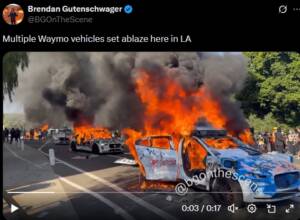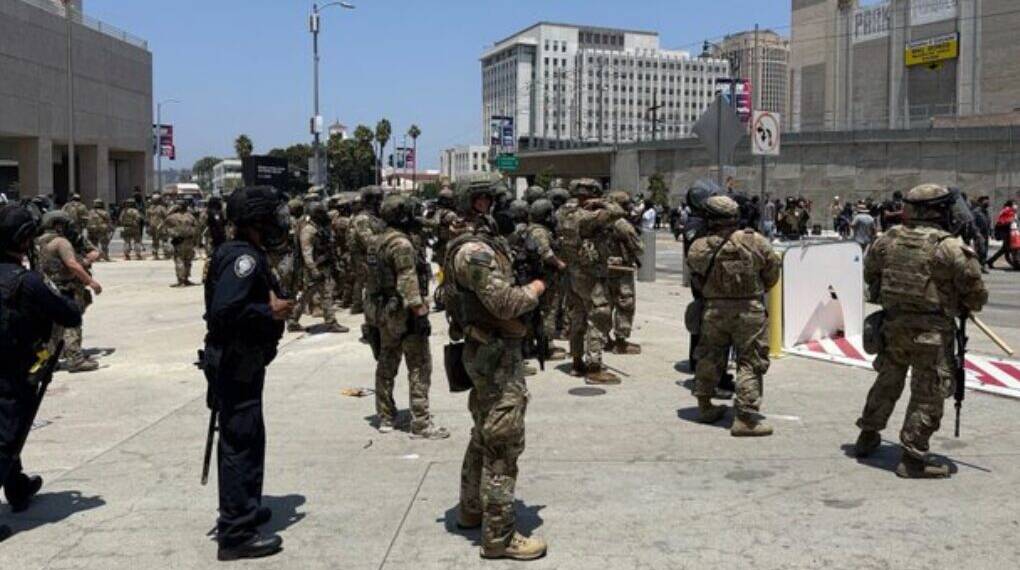A wave of immigration raids by federal agents has sparked fiery protests, citywide unrest, and a controversial deployment of National Guard troops in Los Angeles — a city now gripped by political and civil tension not seen in decades.
Over the weekend, Los Angeles and surrounding communities like Paramount and Compton saw mass protests, widespread disruption, and violent confrontations with law enforcement after Immigration and Customs Enforcement (ICE) carried out sweeping enforcement operations across the city.

As demonstrators flooded streets and freeways, lighting self-driving vehicles on fire and clashing with police, President Donald Trump took the rare step of federalizing over 2,000 National Guard troops without state approval, escalating tensions with California officials and igniting a nationwide debate over executive power.

How the Protests Began?
The unrest began on Friday, June 7, when ICE agents conducted coordinated raids at multiple locations across Los Angeles. Targets included two Home Depot stores, a doughnut shop, and a clothing warehouse in the Fashion District. Officials said the operations aimed to detain individuals using fraudulent documents, and that some of those arrested had links to criminal networks.
Videos from the scene show community members swarming ICE vehicles, shouting at agents and calling for the release of detained workers. “ICE out of Paramount. We see you for what you are,” one protester declared through a megaphone.

As the weekend progressed, the protests quickly spread. Demonstrators gathered outside detention centers, blocked major roads including the 101 Freeway, and threw debris at officers. Several Waymo self-driving cars were torched, and authorities declared unlawful assemblies across multiple city blocks.
Dozens Detained, Union Leader Among Those Arrested
According to the Department of Homeland Security, 118 immigrants were detained during the week, including 44 on Friday alone. Officials also confirmed the arrest of five individuals allegedly linked to organized crime.
In addition, eight American citizens were arrested in Paramount for obstructing federal operations. Among them was David Huerta, regional president of the Service Employees International Union (SEIU), who was held at the Metropolitan Detention Centre. Juveniles involved in protests were detained but later released to guardians.
California Rep. Nanette Barragán warned that ICE operations would continue daily for the next 30 days, prompting further concern among community groups and local leaders.
Trump Deploys National Guard Without Governor’s Consent
With the situation intensifying, President Trump invoked Title 10 of the U.S. Code on Saturday night, federalizing the California National Guard and dispatching over 2,000 troops to Los Angeles County for a 60-day mission. The move bypassed the usual requirement for state approval, sparking immediate backlash from California leaders.
In a post on Truth Social, Trump wrote:
“If Governor Gavin Newscum, of California, and Mayor Karen Bass, of Los Angeles, can’t do their jobs… the Federal Government will step in and solve the problem, RIOTS & LOOTERS, the way it should be solved!!!”
Trump said the deployment was necessary to restore law and order, citing violent clashes, property destruction, and threats to federal personnel as justification.
Also read: Los Angeles erupts as protesters clash with authorities, why are parts of the US burning?
California Officials Condemn Federal Intervention
Governor Gavin Newsom blasted the deployment as “a serious breach of state sovereignty,” warning that the move was “purposefully inflammatory” and would further escalate tensions. He urged Defense Secretary Pete Hegseth to rescind the order.
Los Angeles Mayor Karen Bass was equally critical, saying the federal immigration raids and subsequent troop deployment had created “chaos and fear” in vulnerable communities.
“When you raid Home Depots and workplaces, when you tear parents and children apart… you cause fear and panic, not safety,” she said.
U.S. Representative Maxine Waters described the federal response as “outrageous,” accusing Trump of using the crisis for political gain.
“I think he’s up to creating martial law,” she told reporters.
Legal and Historical Context
The use of Title 10 authority to federalize the National Guard without a governor’s request is rare but not unprecedented. It was most notably used during the Civil Rights era to enforce federal mandates in Southern states. Legal analysts note that while the president has broad powers during national emergencies, such actions are likely to be challenged both politically and, potentially, in court.
What’s Next for Los Angeles?
As National Guard troops continue to patrol parts of downtown Los Angeles and major transit corridors, the city remains tense. Protesters have vowed to continue demonstrations, while civil rights groups are monitoring the use of force closely.
Legal experts anticipate potential challenges to the constitutionality of the federal deployment, especially as the standoff between state and federal authorities shows no sign of easing.
In the meantime, federal officials insist that enforcement actions and troop presence will continue until what they describe as “widespread threats to public safety and federal operations” are neutralized.
Los Angeles, now a flashpoint in a national struggle over immigration, state rights, and the role of the federal government, is bracing for what may be a long and uncertain road ahead.








